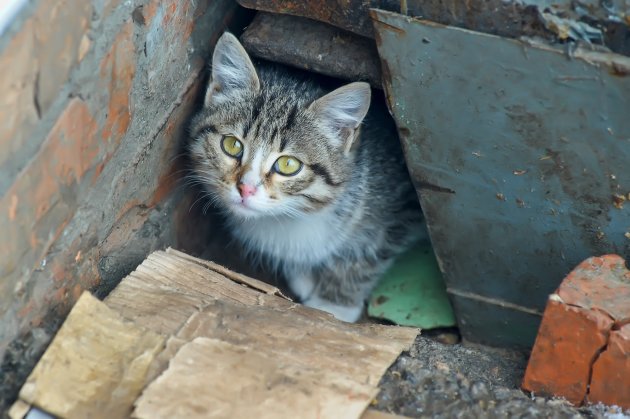Have you stumbled across a cat outdoors? If you are in a position to help a lost cat, read on to learn which actions you must take.
The Important Difference Between a Feral and a Stray Cat
Before you take any action to help, you need to distinguish what type of feline you are dealing with.

What is a Feral Cat?
Cats that grew up in the wild or in the streets with little to no human interaction are called feral cats. While these cats bond well with their colony members, they do not socialize with humans at all. Feral cats are apprehensive of humans. These whiskered fellows do not enjoy living indoors nor are they willing to become pampered lap cats.
Therefore, it is best to keep your distance if you think you might be dealing with a feral cat. If you try to pet it, it will hiss, run, or even claw your hand.
However, you can bring a feral kitten into your home. If you provide all the tender loving care you could give during this crucial growth window, the feral kitten can grow to be as affectionate and playful as any pet cat.
What is a Stray Cat?
A stray cat is a pet that has been abandoned by its owners or has simply wandered away from home. When human contact dwindles, a stray can also adopt feral behaviors. Stray cats that struggle in brutal environments or have become fearful of humans due to abuse are most likely to become feral over time.

How Do You Tell Feral Cats and Strays Apart?
A stressful or frightening event, such as caging, makes it difficult to distinguish a feral cat from a stray. Some friendly strays may show aggression towards humans when they are afraid. Thus, it is best to observe cats on their own outdoors. The following are a few signs to help you distinguish which cat category you are dealing with:
Location
Stray cat – It is very likely that you will find a stray peeking out under your porch. Stray cats often hang around in residential areas and parking lots. They also hover near food establishments in hopes of getting a meal.
Feral cat – According to the Journal of Wildlife Management, feral cats roam over great distances in search of a suitable place that will protect them through harsh summers and unforgiving winters. Since feral cats avoid human interaction, they often hide in vacant lots, abandoned buildings, farms, and prairies.
Socialization with other cats
Stray cat – A stray tends to live alone and avoid conflict with a feral cat.
Feral cat – Feral cats often roam together in groups.
Vocalization and body language
Stray cat – While some strays are shy and wary of strangers, they are still likely to make eye contact with you. If you feed a stray, the whiskered fellow is more likely to meow at you and stand with its tail up – a sign of friendliness.
Feral cat – Feral cats refuse to talk or make eye contact with humans. A feral cat curls down to the ground with its tail wrapped around its body. Likewise, a feral cat is more likely to flee if you approach it.
Schedule
Stray cat – Strays are active during the day.
Feral cat – Feral cats are primarily visible at night, although you may occasionally see them darting into the woods during the day.
Physical Appearance
Stray cat – Stray cats, particularly those who used to be pampered pets, have a shabby look about them. They may be dirty, disheveled, and have matted hair.
Feral cat – Feral cats look clean and well kept, as they are used to taking care of themselves. The males may show scars, as noisy fights are common in feral cats.

What to Do If You Find a Feral Cat
Don’t adopt a feral cat
Feral cats are not suitable pets. These felines have no desire to lounge on your sofa and wait for their next meal. Nor do they appreciate the importance of a litter box. More so, they have no interest in humans. In other words, feral cats love to exercise their freedom to the fullest and let their ancient instincts kick in.
You can feed them
Feral cats live a rough life. If you want to exercise your good intentions, you can give them food and water. If you suspect them to be living in the woods, you can build them little cat houses to protect them from the elements rather than bring them into your home. With ideal living conditions and daily feedings, a feral cat can live up to ten years. In time, the wild feline will approach you and let you know if you can touch him.
Apply the TNR method
Feral cats can’t be taken as pets, thereby calling animal control and surrendering these felines to shelters often leads them to their demise. While you don’t want these felines to be euthanized, you also don’t want an endless cycle of pregnancy. The problem with feral cats is that they multiply too quickly. The most sensible solution is to apply the Trap, Neuter, & Release method.
As the name suggests, the TNR method involves trapping feral cats and bringing them to a veterinary clinic where they are neutered or spayed. They are also vaccinated for rabies before they are released back into their original territory. There are many advantages to the TNR method and hence, many municipalities are supporting this program. There may be volunteering professionals in your community that can help you, too.

What to Do If You Find a Stray Cat
Identify who the cat belongs to
After finding a stray, the next step is to know whether it is indeed a stray in need of a new home or someone’s missing pet. It is very likely that the cat is lost if it is wearing a collar with ID. You may call the name listed on the tag. Unfortunately, not all owners bother putting a tag on their cats. Let alone a microchip.
Ask around
It is also a good idea to ask people in your neighborhood. You may also search for “Lost Cat” posts on social media sites. Nowadays, owners usually post about their missing pets on their social media accounts. There is also a chance that you can help reunite a cat with its owner by utilizing your social networks.
Contact your animal shelter
Let your local animal shelter know that you have found a lost cat. Understand that it may take several days or even a couple of weeks before you can find the cat’s owner. If you don’t have the capacity to foster a cat, you can ask the shelter to bring the cat in.
Take the cat to the vet
Make sure the cat receives a clean bill of health before you bring it to your home, especially if you already have pets. In the event that no one is looking for your feline guest, then perhaps it is time you can call the cat your own.
Conclusion
If you are thinking of adopting your newfound friend, make sure to have him checked with the vet to avoid the spread of infectious diseases to your other pets. As for feral cats, you may want to implement the TNR method first before you proceed on doing favors for your feline neighbors.
If you are still unsure what to do, you can call rescue organizations, humane society, or animal groups in your community. You can also make a complaint in situations where you found out that the wandering feline has a home, but it isn’t treated well.